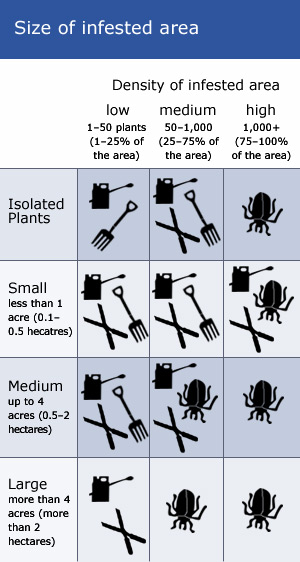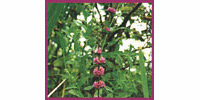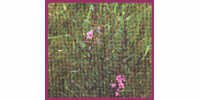Purple Loosestrife: What you should know, what you can do
The Arrival
Purple loosestrife (Lythrum salicaria), a beautiful but aggressive invader, arrived in eastern North America in the early 1800’s. Plants were brought to North America by settlers for their flower gardens, and seeds were present in the ballast holds of European ships that used soil to weigh down the vessels for stability on the ocean. Since it was introduced, purple loosestrife has spread westward and can be found across much of Canada and the United States.
The Problem
Purple loosestrife is a very hardy perennial which can rapidly degrade wetlands, diminishing their value for wildlife habitat. Wetlands are the most biologically diverse, productive component of our ecosystem. Hundreds of species of plants, birds, mammals, reptiles, insects, fish and amphibians rely on healthy wetland habitat for their survival.
However, when purple loosestrife gets a foothold, the habitat where fish and wildlife feed, seek shelter, reproduce and rear young, quickly becomes choked under a sea of purple flowers. Areas where wild rice grows and is harvested, and where fish spawn, are degraded. An estimated 190,000 hectares of wetlands, marshes, pastures and riparian meadows are affected in North America each year, with an economic impact of millions of dollars.
Purple loosestrife also invades drier sites. Concern is increasing as the plant becomes more common on agricultural land, encroaching on farmers’ crops and pasture land.
The Challenge
Many organizations throughout North America have taken action to control the spread of purple loosestrife. Their response has been characterized by unparallelled cooperation. National wildlife services, state/provincial natural resource and environment agencies, universities, nursery trades associations, and conservation and community organizations have responded to the purple loosestrife invasion by raising awareness of the threat posed by this invasive plant, and how to prevent its spread.
Individuals, resource managers and community groups can make a valuable contribution to conserving our wetlands for future generations by acting on the information in this brochure.
Guidelines for Purple Loosestrife Control
How to identify Purple Loosestrife
Before control activites begin, use the following diagram to be sure you are correctly identifying purple loosestrife.
Leaves: Leaves are downy, with smooth edges. They are usually arranged opposite each other in pairs which alternate down the stalk at 90 degree angles, however, they may appear in groups of three.
Perennial Rootstock: On mature plants, rootstocks are extensive and can send out up to 30 to 50 shoots, creating a dense web which chokes out other plant life.
Guidelines for Purple Loosestrife Control:Don’t be fooled by these look-alikes…
How to control Purple Loosestrife
Controlling the spread of purple loosestrife is crucial to protecting vital fish, wildlife and native plant habitat! Purple loosestrife can easily spread if improper control methods are used. The following simple guidelines will ensure that your efforts to control the spread of purple loosestrife are effective.
Estimate the size and density of the infestation, and use the following chart to choose one or more appropriate loosestrife control options.
In areas too heavily infested to pull, cut or dig plants, these control techniques can still be used to control plants that may sprout as a result of seeds escaping the area. Watch drainage ditches or streams leading from heavily infested areas, as new purple loosestrife colonies are likely to become established there. Pulling, cutting, or digging plants in these more manageable infestations will limit the spread of purple loosestrife beyond the area of heavy infestation.

Key to Chart Symbols
Digging & Hand Pulling: Pulling purple loosestrife by hand is easiest when plants are young (up to two years) or when in sand. Older plants have larger roots that can be eased out with a garden fork. Remove as much of the root system as possible, because broken roots may sprout new plants.
Cutting: Removing flowering spikes will prevent this year’s seeds from producing more plants in future years-- remember each mature plant can produce over 2 million seeds per year. Also, remove last year’s dry seed heads, as they may still contain seeds. Finally, cut the stems at the ground to inhibit growth.
Biological Control: In areas of severe purple loosestrife infestation, manual and chemical control efforts are ineffective and may in fact contribute to the problem. However, the use of specially selected insects that feed on purple loosestrife is being studied to determine the effectiveness of this method for long-term control in these higher density areas. Biological control is discussed in more detail in a following section.
Chemical Control: If an infestation is in a dry, upland area, and on your own property, an approved herbicide can be applied to individual plants by selective hand spraying. Broadcast spraying is not recommended as it kills all broad-leaved plants, leaving the area open to further invasion from nearby sources of purple loosestrife. This also provides an opportunity for seeds present in the soil to sprout.
Chemical control is used in the United States to control purple loosestrife near or in water, however, as of 1996, no herbicide has been approved for this type of application in Canada. NOTE: In the U.S. a permit is required; call a state natural resource agency for more information.
Things to Keep in Mind
- The best time to control purple loosestrife is in late June, July and early August, when it is in flower. Plants are easily recognized, and it has not yet gone to seed. Once flower petals start to drop from the bottom of the spike, the plant begins to produce seed. Control activities can continue during this time, but require greater care so seeds are not shaken from the plant. At sites where plants have gone to seed, remove all of the flowering spikes first by bending them over a plastic bag and cutting them off into the bag. Further cutting of stems or pulling can now take place without fear of spreading the tiny seeds.
- Proper disposal of plant material is important. Put all plant pieces in plastic bags (vegetation rots quickly in plastic) and take the bags to a sanitary landfill site. Be sure the landfill site doesn’t require bags to be broken open for composting. Composting is not advised, as purple loosestrife seeds may not be destroyed and the thick, woody stem and roots take a long time to decompose. If facilities exist in your area, incineration is an effective way to dispose of plant material.
- Be aware that your clothes and equipment may transport the small seeds to new areas. Thoroughly brush off your clothes and equipment before leaving the site.
- Keep site disturbance to a minimum. Wetlands provide habitat for many native song birds, waterfowl, mammals, amphibians, and fish which depend on native wetland vegetation. Wetlands are also home to many rare and delicate plants. Take care not to trample or damage native vegetation when controlling purple loosestrife.
Why biological control?
When a plant from one continent is introduced to another, it usually leaves behind the natural enemies that help prevent population explosions where it normally grows. The purpose of biological control (biocontrol) is to reunite a plant with its natural enemies. Complete eradication is unlikely; the goal of biocontrol is to reduce numbers of the target plant to lessen its ability to displace native vegetation.
The aggressive spread of purple loosestrife across North America prompted the consideration of biological control in the battle against this invader.
Obviously, extreme caution must be taken when introducing one organism to control another. Prior to any introduction of a biological control agent, intensive testing is conducted to ensure that a safe and effective agent is selected.
Selection and screening procedures
Before approval is granted to release biological control agents in Canada or the U.S., years of testing are required to determine host specificity and ecological specificity.
Testing is usually done in Europe by the International Institute of Biological Control in collaboration with Canadian and U.S. scientists. This enables controlled laboratory testing and natural field testing to be conducted in the insects’ native home, eliminating the high cost of meeting the requirements for working in North American quarantine to avoid the risk of a foreign species escaping.
Once testing is completed, a report is written for submission to a Canadian Advisory Committee and a U.S. Technical Advisory Group. If both the Canadian and U. S. representatives are satisfied that the benefits outweigh the risks, they recommend the release of biological control agents.
Once approved for release in Canada or the U.S., insects must pass through national quarantine facilities to ensure that they are the correct species and are free of disease and parasites. A limited number of insects are imported for use as brood stock, to reproduce and supply additional insects for release.
Finding biological controls
In the mid-1980’s, biologists began to conduct a search for biological control agents of purple loosestrife. Of the more than 100 insects that feed on purple loosestrife in Europe, several species were thought to have had excellent potential. Testing began in Europe and was completed in North America between 1987 and 1991, prior to the insects being approved for release. Included in the tests were “feeding trials,” which exposed the insects to approximately 50 species of plants, including wetland species native to North America and important commercial and agricultural species.
Following the rigorous testing process and evalution of the test results, five species of beetles received approval for release in North America, first from the United States government, and then from the Canadian government in 1992.
The following five species of beetles were selected for purple loosestrife to be introduced without fear of negative impacts to native North American plants. Galerucella pusilla and G. calmariensis are leaf-eating beetles which seriously affect growth and seed production by feeding on the leaves and new shoot growth of purple loosestrife plants. Hylobius transversovittatus is a root-boring weevil that deposits its eggs in the lower stem of purple loosestrife plants. Once hatched, the larvae feed on the root tissue, destroying the plant’s nutrient source for leaf development, which in turn leads to the complete destruction of mature plants. Finally, two flower-eating beetles, Nanophyes breves and N. marmoratus, severely reduce seed production of purple loosestrife.
Release and monitoring protocol
Since the initial importation of these insects into North America for the biological control of purple loosestrife, three of the control agents have been released in Canada, including H. transversovittatus, G. pusilla, and G. calmariensis; the United States has released these as well as N. marmoratus. The other flower-eating beetle has yet to be released in North America.
As of 1996, insects have been released for the control of purple loosestrife in twenty-five U.S. states and seven Canadian provinces.
At the time of insect release, site characteristics including habitat and soil type, size of infestation, and water levels are recorded. Follow-up visits to the site occur later in that season, and in subsequent years, so that survival and establishment of the beetles can be assessed and their impact on the plant population evaluated.
The impact of biological control on purple loosestrife
Scientists expect that once established at initial release sites, insect populations will increase, effectively reducing the density of purple loosestrife by reducing shoot growth, preventing or delaying flowering, and reducing seed production. When the number of loosestrife plants on a site dwindles, the beetles will move to other loosestrife stands to feed. Since the control agents will never completely eradicate loosestrife populations, there will be a food source for remaining insect populations.
In North America, it is hoped that the impact of the biological control agents will result in reductions of purple loosestrife abundance by approximately 80%. However, this is a long-term goal. It is estimated that it will be 10 to 20 years after the insect populations become established before their densities will be high enough to result in this reduction.
In the meantime, it is important that we work together to control the spread of purple loosestrife to new areas by using the guidelines outlined previously.
Releasing Galerucella sp. at a site. Inset left: H. transversovittatus, a root-boring weevil, is about eight millimeters long. Inset right: Galerucella sp. is approximately four millimeters in length.
Is Purple Loosestrife growing in your garden?
In some states and provinces, noxious weed laws or other state/provincial laws make it illegal to plant purple loosestrife (Lythrum salicaria) and its cultivars. However, it is still legally available for sale at some locations. DO NOT BUY IT! Also, purple loosestrife seeds are present in some wildflower seed mixes— check the label before you buy any seed packages.
Garden varieties of loosestrife, which were once thought to be sterile, have been proven to cross pollinate with wild purple loosestrife to produce viable seed. Gardeners can help control the spread of this plant and protect our environment from its harmful impacts by not planting purple loosestrife or the following cultivars:
- Atropurpureum
- Brightness
- Columbia Pink
- Dropmore Purple
- Firecandle
- Flashfire
- Floralie
- Florarose
- Gypsy Blood
- Happy
- Lady Sackville
- Morden Gleam
- Morden Pink
- Morden Rose
- Pink Spires
- Purple Dwarf
- Purple Spires
- Robert
- Rose Gem
- Rose Gleam
- Rose Queen
- Roseum superbum
- Rosy Glow
- The Beacon
- The Rocket
- Tomentosum
Alternative plantings for the Purple Loosestrife
If you currently have purple loosestrife or a cultivar growing in your garden, it could contribute to the loss of fish and wildlife habitat. Please remove it (roots and all) or at least cut off the flower tops before they begin to form seed. For proper disposal, please see the section “Things to Keep in Mind.”
The Canadian Nursery Trades Association has discouraged the sale of purple loosestrife by its members. As a result, many garden centers and seed distribution companies have responded to the purple loosestrife epidemic by voluntarily refusing to sell purple loosestrife and its cultivars, and by providing an alternative selection of environmentally-friendly perennials to landscapers and home gardeners.
Several species of garden perennials display characteristics similar to purple loosestrife, yet they pose no threat to our natural environment. The following plants are an example of some of the environmentally-friendly species available at garden centers and nurseries:
- Blazing Star, Gay Feather (Liatris spp.) There are several species of Liatris that are native to North America. Plants grow flowering spikes of blue, pink or purple. Availability and appropriateness of the Liatris species and their varieties will vary in the different geographic areas of North America.
- Delphinium (Delphinium spp.) This traditional perennial grows up to 2m (6') tall producing a brilliant spike of blue to purple flowers. Individual flowers are about 5-7.5 cm (2-3") with a single or double ring of petals. Delphinium grows best in full sun.
- False Spirea (Astilbe arendsii) Astilbe grow 0.75-1m (2-3') tall and form 20 to 30 cm (8-12") spikes of tiny flowers ranging in color from purple to pink and crimson. Astilbe grows in moist but well-drained soil and in light shade where it will not dry out too quickly during the summer months.
- Foxglove (Digitalis purpurea) This poplular perennial grows to a height of 1-1.25m (3-4') and produces masses of bright flowers in a range of colors that bloom in early summer. Foxglove grows best in full sun.
- Lupine (Lupinus) This spectacular perennial provides flowers in a variety of colors ranging from blue to pink and yellow. The flowers form large 0.5m (2') spikes along the 1-1.75m (3-5") stem. Lupines grow best with full sun and in well-drained, neutral or slightly acidic soils.
- Lobelia (Lobelia cardinalis) A wildflower of wet areas in North America. This plant has spikes of scarlet-red flowers in summer. Excellent beside a pond or stream.
- Obedient Plant (Physostegia virginiana) Also known as the False Dragonhead, this native plant has showy, 2.5 cm (1") flowers in pairs on spikelike clusters that appear from July to September. Two cultivars that have pink blossoms are “Bouquet Rose” and “Vivid.”
- Salvia (Salvia superba) Salvia is a hardy perennial that is drought resistant and somewhat bug-proof. Most Salvia have blue to violet flowers, appearing as spikes during June and August. Plants grow 0.75-1m (2-3') tall, preferring full sun and good garden soil.
- Siberian Iris (Iris) Siberian Iris has purple flowers with typical iris-shaped blooms. It grows best in moist but well-drained soil and prefers acidic soils (pH 5.5 to 6.5); sulphur can be added to help acidify the soil.
- Spike Speedwell (Veronica spicata) This plant will grow about 40 cm (18") tall with blue or pink flowers in dense, spikelike racemes. It grows well in well-drained soil with full sun.
The information on this Web page was originally produced in brochure form by the Ontario Federation of Anglers and Hunters with support and cooperation of:
- Canadian Wildlife Service
- Canadian Nursery Trades Association
- Ducks Unlimited Canada
- Manitoba Purple Loosestrife Project
- Minnesota Department of Natural Resources
- Ontario Ministry of Natural Resources
- U.S. Great Lakes Sea Grant Network
- University of Guelph
For More Information
If you would like more information about purple loosestrife, the problems it causes, regulations to prevent its spread, or methods and permits for its control, contact:
- Ontario Federation of Anglers and Hunters
- P.O. Box 2800
- Peterborough, Ontario
- K9J 8L5
- Minnesota-DNR
- Purple Loosestrife Program
- 500 Lafayette Road
- St. Paul, MN 55155-4025
- 651.259.5100
- University of Minnesota
- Minnesota Sea Grant Program
- Exotic Species Info Center
- 2305 East 5th Street
- Duluth, MN 55812-1445
- 218.726.8712
Related Pages:
- Species Profile: Purple Loosestrife
- Purple Loosestrife: What You Should Know, What You Can Do
- Biological Control of Purple Loosestrife, 4-H Leader's Manual

- Where Have All the Purple Flowers Gone? (Seiche, Sept. 2002)
- Preparing for Purple Eaters (Seiche, August 2001)
- Seeing Purple? Is It Loosestrife? (Seiche, Sept. 2000)











 Doug Jensen
Doug Jensen


